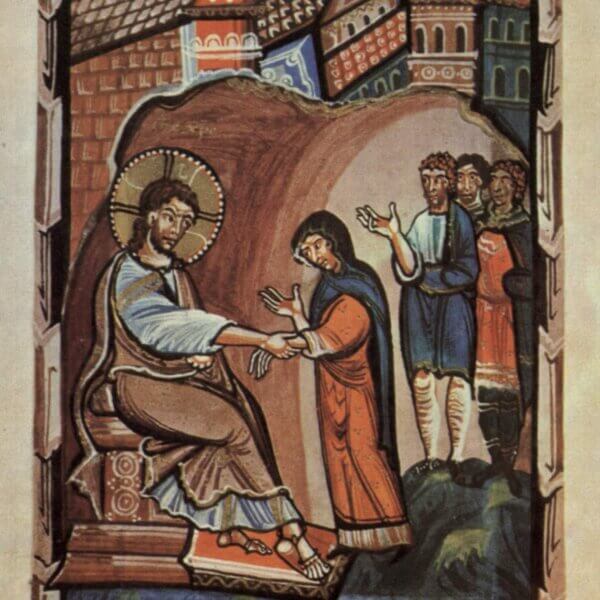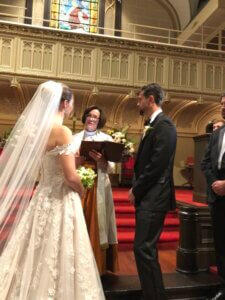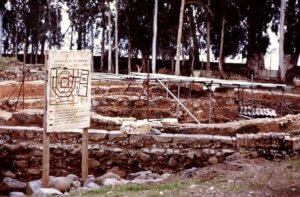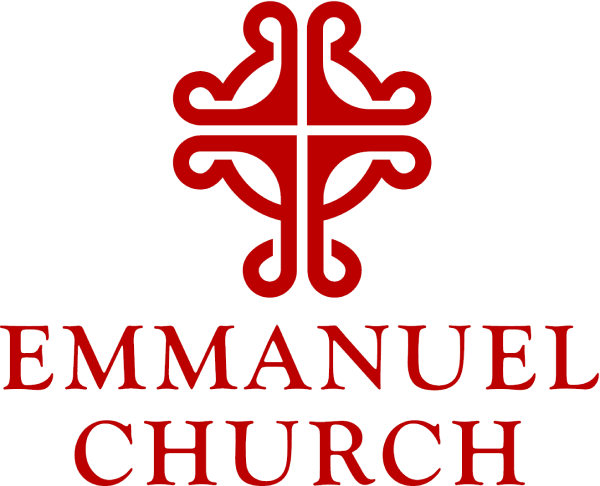
Gracious, all-knowing God, you show us how to see into corners and notice those on the margins through Jesus’ ministry in Capernaum. You saw and healed Peter’s mother-in-law Lord, and we know that there’s really only one way to get one of those. So help us, God, to see Peter’s wife, and all the other women, children, and men of Galilee who loved Jesus and served and helped him in his ministry. Help us always to notice, loving God, all those we don’t see — those who are hidden by the side of the road, outside the door, under a burden, on the edge of the crowd, or behind our assumptions, and to see you in their eyes. We ask all this in your holy name. Amen
The Mother-in-Law
 About a year and a half ago, I became a mother-in-law. Twice. By my own doing, too, as I was both officiant and mother — first of the bride in the mountains of North Georgia in Aubrey and Nick’s wedding, and then, four months later in New Orleans, the mother of the groom as I married Judson and Sofia. While looking through Emmanuel’s zip files for digitized building plans of the chancel this last week (that’s another whole story — ask me at announcements) I came upon the video of Aubrey and Nick’s wedding in June of 2022 and got lost in that very happy day for about 20 minutes. After the proclamation of marriage, where the officiant says I now pronounce you husband and wife, the wedding video close-up catches me exchanging a mischievous look with Nick, my just that moment new son-in-law: Yep, you just married me too! We’re all family now! I went a step further after the proclamation of marriage in Judson and Sofia’s wedding, introducing them as my new daughter-in-law Sofia, and her husband, Judson Wells, claiming my own place in the new family.
About a year and a half ago, I became a mother-in-law. Twice. By my own doing, too, as I was both officiant and mother — first of the bride in the mountains of North Georgia in Aubrey and Nick’s wedding, and then, four months later in New Orleans, the mother of the groom as I married Judson and Sofia. While looking through Emmanuel’s zip files for digitized building plans of the chancel this last week (that’s another whole story — ask me at announcements) I came upon the video of Aubrey and Nick’s wedding in June of 2022 and got lost in that very happy day for about 20 minutes. After the proclamation of marriage, where the officiant says I now pronounce you husband and wife, the wedding video close-up catches me exchanging a mischievous look with Nick, my just that moment new son-in-law: Yep, you just married me too! We’re all family now! I went a step further after the proclamation of marriage in Judson and Sofia’s wedding, introducing them as my new daughter-in-law Sofia, and her husband, Judson Wells, claiming my own place in the new family.
Mothers-in-law are often known by role and not by name. There can be that weird discomfort in the early days of a marriage, wondering what to call your mother-in-law — a problem that is often solved by grandchildren. I think that my name is Dede now, thank the Lord, as Mrs. Wells just isn’t a big enough idea to contain all that my kids’ spouses and I are now to one another. Even accounting for different life experiences, marital outcomes, choices, and contexts, knowing, knowing of, being, or having a mother-in-law is a very common experience.
 Even if you’re not a mother-in-law like I am, or if you don’t have one now, maybe you once did. Or maybe you had a grandmother who was a mother-in-law to one of your parents at some point, or knew someone who did. In any case, a mother-in-law is a very special relationship — official and legally recognized as well as personal and familial. Many of Jesus’ first disciples were related: Simon Peter and Andrew were brothers, as were James and John. And we know from other stories in the gospel that Jesus himself had brothers who were involved in the ministry, and Jesus was also very close to Lazarus and his two sisters, Mary and Martha.
Even if you’re not a mother-in-law like I am, or if you don’t have one now, maybe you once did. Or maybe you had a grandmother who was a mother-in-law to one of your parents at some point, or knew someone who did. In any case, a mother-in-law is a very special relationship — official and legally recognized as well as personal and familial. Many of Jesus’ first disciples were related: Simon Peter and Andrew were brothers, as were James and John. And we know from other stories in the gospel that Jesus himself had brothers who were involved in the ministry, and Jesus was also very close to Lazarus and his two sisters, Mary and Martha.
Family Relationships
All those are family relationships, which makes sense, as preacher Lawrence Wood reflects, because the early church was very much a family affair… [and] …even today it grows through relationships, one person at a time. There’s something more and different going on in our gospel today, though, where Simon Peter’s mother-in-law is the central point in the story. With his brother Andrew and the brothers James and John of Zebedee in tow, Simon Peter enters his house with Jesus. Simon Peter’s mother-in-law was in bed with a fever, Mark’s gospel tells us, and the two pairs of brothers, Simon Peter and Andrew, and James and John of Zebedee, crowded into Simon Peter’s house and told Jesus about Simon Peter’s mother-in-law at once — right away.
 I wonder what her name was — was it Ruth? Naomi? Debra? Martha? Tabitha maybe? Or Dede, like me, or another grandmother name? Mark’s gospel doesn’t say. Instead, it describes her by her relationship to Simon Peter — his mother-in-law — and not by name, ethnic origin (was she a Galilean?) or hometown. Identifying Simon Peter’s mother-in-law by her role does something else: it reveals the warp and weave of the relationships around her — the very fabric of the community. If instead she had been Simon Peter’s mother, she would have been Andrew’s mother too. But as it was, she was not related by blood to either one of them, but instead, was chosen family, official and legally recognized as well as personal and familial. We also know, that while mothers-in-law are common, there’s pretty much only one way to get them, so Simon Peter must also have had, or at least once have had, a wife. And if he had a wife, did he have children? Did Simon Peter’s brother Andrew also have a mother-in-law? Did she have a grandmother name, meaning a houseful of cousins, and also a whole other family line connected to Simon Peter?
I wonder what her name was — was it Ruth? Naomi? Debra? Martha? Tabitha maybe? Or Dede, like me, or another grandmother name? Mark’s gospel doesn’t say. Instead, it describes her by her relationship to Simon Peter — his mother-in-law — and not by name, ethnic origin (was she a Galilean?) or hometown. Identifying Simon Peter’s mother-in-law by her role does something else: it reveals the warp and weave of the relationships around her — the very fabric of the community. If instead she had been Simon Peter’s mother, she would have been Andrew’s mother too. But as it was, she was not related by blood to either one of them, but instead, was chosen family, official and legally recognized as well as personal and familial. We also know, that while mothers-in-law are common, there’s pretty much only one way to get them, so Simon Peter must also have had, or at least once have had, a wife. And if he had a wife, did he have children? Did Simon Peter’s brother Andrew also have a mother-in-law? Did she have a grandmother name, meaning a houseful of cousins, and also a whole other family line connected to Simon Peter?
This story of Jesus’ healing Simon Peter’s mother-in-law frames the whole project of healing and driving out demons that unfolds next. I’ve spent a lot of time around the archeological site that the Church remembers as Simon Peter’s house. Even after the small stone house on the edge of the Sea of Galilee was built out in the fifth century into a Roman era church, it’s still small — not much bigger than the area of the chancel (where the choir sits) here at Emmanuel. And into that tiny space, no fewer than five men entered where a woman — unrelated to any of them by blood — lay in bed with a fever, which almost 2,000 years before the invention of penicillin could easily have resulted in her death. Then Jesus, a Jewish man, risked ritual impurity and dangerous contagion to go to her bedside — a brave, loving, and very familiar thing to do — the sort of thing a family member might do, even though she was his mother-in-law, specifically not related to Simon Peter, and definitely not related to Jesus. Jesus took Simon Peter’s mother-in-law by the hand and lifted her up. Then the fever left her, and she began to serve them.
 Before we see this scene with our 21st century eyes and attitudes and conclude that Simon Peter’s mother-in-law resumed a woman’s role serving men, note that the Biblical Greek verb translated as serve is diekonei, the source of the word deacon. Simon Peter’s mother-in-law was the first to respond as so many others would, profoundly moved by the great change in her life, becoming the first deacon in the sense that she became a servant to all in response to Jesus’ radically inclusive love. Jesus’ love is boundless, including not only blood family, or the first century Galilean Jews under Roman occupation, but particularly and specifically those who are outside blood relations and other privileged status categories, like Simon Peter’s mother-in-law. We don’t even know her name, or where she’s from, but Jesus heals her all the same.
Before we see this scene with our 21st century eyes and attitudes and conclude that Simon Peter’s mother-in-law resumed a woman’s role serving men, note that the Biblical Greek verb translated as serve is diekonei, the source of the word deacon. Simon Peter’s mother-in-law was the first to respond as so many others would, profoundly moved by the great change in her life, becoming the first deacon in the sense that she became a servant to all in response to Jesus’ radically inclusive love. Jesus’ love is boundless, including not only blood family, or the first century Galilean Jews under Roman occupation, but particularly and specifically those who are outside blood relations and other privileged status categories, like Simon Peter’s mother-in-law. We don’t even know her name, or where she’s from, but Jesus heals her all the same.
Like our reading from Isaiah this morning describes God’s care for each of us, he brings them out and numbers them, calling them all by name, [and] because he is great in strength and mighty in power, not one is missing — including all of us listening in now. And this is our message from first Corinthians too, as Paul becomes all things to all people crossing all kinds of lines and differences in order to win some to this radical course of love that is open to everyone — even us in-laws and outlaws, as I’ve sometimes heard us called, all for the sake of the gospel, so that we can all share in its blessings. Amen
